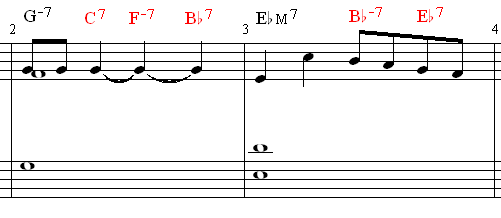In part 1 of this series we started looking at the first 4 measures of the Mel Torme version of the Christmas song. Taking a simple look at analyzing the song for time signature, key signature, rhythm and the basic chord progression for the four measures.
We noted that the chords were made hip by applying major and minor 7th intervals to each of the chords in the harmonic system.
In this part of the series we are going to take two more steps and look at the base notes and then add additional chords that were used in Mel's arrangement. Here's where we left off:

Adding Base Notes
This next part is fairly straight forward, we can add in the appropriate bass note for each of the chords given above. That will look like this with each bass note corresponding to the root of the chord given.

Ok, easy enough. In this case I've decided to use the most of the notes in the middle of the bass clef, this will become more apparent latter as we add more notes and realize that the muddiness sound of lower register notes is avoided.
Adding 7th Intervals
Next we can add the seventh interval based on each of these chords as well. In the first measure we see that the melody note is a D and is the major 7th interval for this chord. However, we are going to go ahead and show it in the base chord. We might do this because the melody might be played by a horn instrument and the resulting chords may be played by a stringed instrument like the piano or guitar.

We've added in the seventh intervals for the rest of the chords. Minor 7th (Eb) for the F-7 chord, minor 7th (F) for the G-7 chord, major 7th again (D) for the EbM7, and another major 7 (G) for the AbM7 in the last measure.
This is a good basic start on putting together the structure of this part of the song.
Now I've highlighted the F note in the treble clef as the 7th of the G-7 chord. Rather than have it associated with the G in the bass or left hand for the piano we can apply that seventh as part of working with the melody.
Of course we'd need to horns if we take that approach to playing or if the piano takes control then we can use the right hand to play these notes. While we are at this measure notice that there are three tied quarter notes.
You might have asked why aren't these a dotted half note or a tied quarter with a half note. Good question and there are a couple of possible answers. In this case we will be using each of these quarter notes to expand our arrangement of chords. Let's do that next.
Adding Chords to Create Movement
In the measures 3 and 4 Mel's arrangement has five additional chords. The addition of these chords adds a lot of movement or flow to the song. And you can see in this cut of those measures the new chords.

These chords are very interesting in that they represent a series of fifth movements of the chords. Let's take a closer look at the flow in measure 2. The G-7 goes to C7 and the F-7 goes to a Bb7. Both of these chord progressions “at the moment” are ii7 to V7 changes which are very common in jazz and classical music.
In the greater scheme of things this is a iii7 to VI7 to ii7 to V7 and then into measure three at the IM7. Get to know this progression it is quite common in many songs.
Take a look at measure three and work on the chord changes there on your own. We'll tackle them in part 3.
Your Assignment
We're going to stop here for this session. Your assignment is to add the base root note and 7th notes for the new chords in the last graphic. Then take time to play the chords and notes on a keyboard to hear the sounds of the melody and the open 7th intervals. Even try filling in some of the chord tones like adding a 3rd or a 5th to see what you create.
Next time we'll pick up from here, fill in some chord notes and explore some other additional chords.
Stay Tuned!